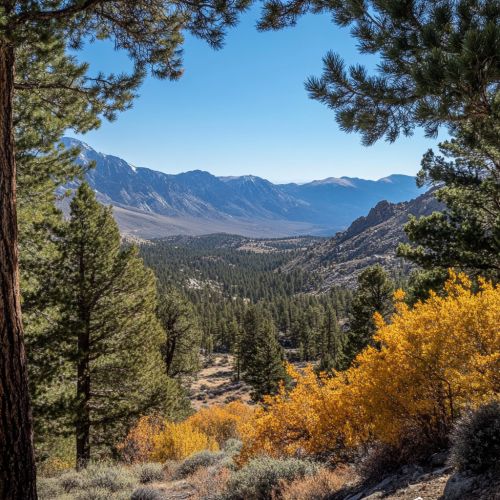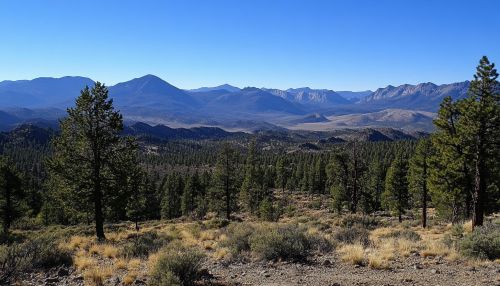Inyo National Forest
Overview
Inyo National Forest is a federally managed forest located in the eastern Sierra Nevada and White Mountains of California and Nevada. It encompasses over 2 million acres of diverse landscapes, ranging from arid deserts to lush alpine meadows. The forest is named after Inyo County, which derives its name from a Native American term meaning "dwelling place of the great spirit."
Geography and Topography
Inyo National Forest spans across several counties, including Inyo, Mono, Fresno, Madera, and Esmeralda. The forest is characterized by its varied topography, which includes the highest point in the contiguous United States, Mount Whitney, standing at 14,505 feet, and the lowest point in North America, Badwater Basin in Death Valley, at 282 feet below sea level.
The forest is divided into several distinct regions:
- The Sierra Nevada Range: Known for its rugged peaks, glacial valleys, and alpine lakes.
- The White Mountains: Home to the ancient Bristlecone Pine forests, some of the oldest living trees on Earth.
- The Owens Valley: A high desert valley that lies between the Sierra Nevada and the White Mountains.
Climate
The climate within Inyo National Forest varies significantly due to its wide range of elevations. Lower elevations experience arid desert conditions with hot summers and mild winters, while higher elevations have a more alpine climate with cold, snowy winters and cool summers. Precipitation is generally low, with most of it falling as snow in the higher elevations during the winter months.
Flora and Fauna
Inyo National Forest is home to a rich diversity of plant and animal species. The vegetation varies from desert scrub and sagebrush in the lower elevations to dense coniferous forests and alpine meadows at higher elevations.
Flora
- Desert Scrub: Dominated by species such as creosote bush, sagebrush, and Joshua tree.
- Montane Forests: Includes species like Jeffrey pine, lodgepole pine, and white fir.
- Alpine Meadows: Characterized by grasses, wildflowers, and low-growing shrubs.
Fauna
The forest supports a wide range of wildlife, including:
- Mammals: Mule deer, black bear, mountain lion, and bighorn sheep.
- Birds: Golden eagle, peregrine falcon, and various species of hawks and owls.
- Reptiles and Amphibians: Western rattlesnake, desert tortoise, and Yosemite toad.
Recreation
Inyo National Forest offers a plethora of recreational opportunities, attracting outdoor enthusiasts from around the world. Popular activities include hiking, camping, fishing, and skiing.
Hiking and Backpacking
The forest boasts an extensive network of trails, including portions of the John Muir Trail and the Pacific Crest Trail. These trails offer access to some of the most scenic and remote areas of the Sierra Nevada.
Camping
There are numerous campgrounds within the forest, ranging from developed sites with amenities to primitive backcountry sites. Popular campgrounds include Convict Lake, Mammoth Lakes Basin, and Rock Creek.
Fishing
The forest's lakes and streams are renowned for their trout fishing. Species such as rainbow trout, brown trout, and golden trout can be found in abundance.
Winter Sports
Inyo National Forest is a prime destination for winter sports, with areas like Mammoth Mountain offering world-class skiing and snowboarding. Cross-country skiing and snowshoeing are also popular activities.
Conservation and Management
The management of Inyo National Forest is overseen by the United States Forest Service. The primary goals are to maintain the health and sustainability of the forest's ecosystems while providing recreational opportunities and protecting natural resources.
Wilderness Areas
Several designated wilderness areas lie within the forest, including:
These areas are managed to preserve their natural conditions and provide opportunities for solitude and primitive recreation.
Fire Management
Fire management is a critical aspect of forest management in Inyo National Forest. The forest service employs various strategies, including prescribed burns and mechanical thinning, to reduce the risk of catastrophic wildfires and maintain healthy forest ecosystems.
Cultural and Historical Significance
Inyo National Forest has a rich cultural and historical heritage. The area has been inhabited by Native American tribes for thousands of years, and their influence is evident in the numerous archaeological sites and petroglyphs found throughout the forest.
Native American Heritage
The forest is home to several tribes, including the Paiute, Shoshone, and Mono peoples. These tribes have a deep connection to the land and continue to practice traditional activities such as hunting, fishing, and gathering.
Historical Landmarks
Several historical landmarks are located within the forest, including:
- Manzanar National Historic Site: A former internment camp for Japanese Americans during World War II.
- Bodie State Historic Park: A well-preserved ghost town that offers a glimpse into the region's mining history.
Research and Education
Inyo National Forest serves as a valuable resource for scientific research and education. The diverse ecosystems and unique geological features provide opportunities for studies in fields such as ecology, geology, and climate science.
Research Programs
Several research programs are conducted within the forest, focusing on topics such as:
- Climate Change: Studying the impacts of climate change on alpine ecosystems and species.
- Forest Health: Monitoring the health of forest ecosystems and the effects of pests and diseases.
- Hydrology: Investigating the hydrological processes and water resources within the forest.
Educational Programs
The forest offers various educational programs and resources for schools, universities, and the general public. These programs aim to promote environmental awareness and stewardship.
Accessibility
Inyo National Forest is accessible via several major highways, including U.S. Route 395, which runs north-south along the eastern edge of the Sierra Nevada. The forest is also served by several smaller roads and trails that provide access to remote areas.
Visitor Centers
There are several visitor centers located within the forest, offering information, maps, and resources for visitors. Notable visitor centers include:
Challenges and Threats
Inyo National Forest faces several challenges and threats, including climate change, invasive species, and human impact.
Climate Change
Climate change poses a significant threat to the forest's ecosystems, with potential impacts including altered precipitation patterns, increased wildfire risk, and changes in species distributions.
Invasive Species
Invasive species, such as cheatgrass and quagga mussels, threaten the forest's native plant and animal communities. Efforts are ongoing to manage and mitigate the impacts of these invasive species.
Human Impact
Human activities, including recreation, development, and resource extraction, can have negative impacts on the forest's ecosystems. The forest service works to balance these activities with conservation efforts to protect the forest's natural resources.
Future Directions
The future management of Inyo National Forest will focus on addressing the challenges and threats facing the forest while continuing to provide recreational opportunities and protect natural resources.
Restoration Projects
Several restoration projects are planned or underway, including:
- Meadow Restoration: Restoring degraded meadows to improve habitat for wildlife and enhance water quality.
- Forest Thinning: Reducing tree density to decrease wildfire risk and improve forest health.
- Riparian Restoration: Enhancing riparian areas to support fish and wildlife populations.
Community Engagement
Engaging with local communities and stakeholders is a key component of the forest's management strategy. Public input and collaboration are essential for developing effective management plans and ensuring the long-term sustainability of the forest.
See Also
- Sierra Nevada
- White Mountains (California)
- John Muir Trail
- Pacific Crest Trail
- Mammoth Mountain
- Manzanar National Historic Site
- Bodie State Historic Park


